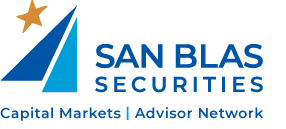Last Week in Review – June 19, 2023 – from Stephen Colavito
Last week, mild inflation and growth signals appeared to help stocks continue a rally that began with only a few interruptions since late May. The S&P 500 Index notched its longest stretch of daily gains since November 2021 and its best weekly performance since the end of March. However, as reflected in the renewed outperformance of growth stocks and large caps, the market's advance narrowed slightly. Markets were scheduled to be closed today in observance of the Juneteenth holiday.
Last Wednesday, officials announced they were holding the official federal funds’ target rate steady in the 5.00% to 5.25% range. However, the “dot plot” summarizing each policymaker’s rate expectations suggested that this was more of a “skip” than a durable “pause” in their rate-hiking schedule, as the median rate projection suggested two more quarter-point hikes by the end of the year.
The major benchmarks pulled back on the release of the data, but our traders noted that the hawkish dot plot seemed to be offset by Chair Jerome Powell’s following press conference, which was interpreted as a bit more dovish. Powell repeatedly stressed that the policy committee had not decided to raise rates and that any further moves would depend on incoming growth and inflation data. “We've moved much closer to our destination,” Powell also allowed, “which is that sufficiently restrictive rate, and I think that means by almost by definition that the risks of overdoing it and…underdoing it are getting closer to being in balance.”
US - MARKETS & ECONOMY
Several signs emerged that the economy was arguably enjoying a “Goldilocks” expansion of continued growth alongside falling inflation. Last Tuesday, the Labor Department announced that the consumer price index had increased at a year-over-year pace of 4.0%— double the Federal Reserve’s target but down from the prior month’s 4.9% and the slowest pace since March 2021. On Thursday, the Labor Department revealed that producer prices had declined 0.3% in May, marking four declines over the past six months.
While falling producer prices partly reflected an ongoing contraction in the manufacturing sector (as well as a substantial drop in food and gasoline prices), investors received some good news on the consumer side of the economy. Retail sales rose 0.3% for the month and 1.6% over the past 12 months, marking the first year-over-year increase since January. Excluding the volatile auto and gasoline segments, sales rose 0.4% in May. Meanwhile, the University of Michigan’s gauge of consumer sentiment rose more than expected and hit its highest level in four months. However, weekly jobless claims were unchanged, defying consensus expectations for a decline from the previous week’s 20-month high.
US – EQUITY MARKET PERFORMANCE
US YIELDS & BONDS
Despite the Fed’s policy announcement, traders noted that fixed-income markets were calm overall, with limited issuance and credit spread movements in most sectors. This may have reflected light activity before the upcoming holiday weekend. However, an active secondary market in bank loans amid steady demand for discounted loans and as some investors sought to take profits following the recent strong performance.
US TREASURY MARKETS – CURRENT RATE AND WEEKLY CHANGE
3 Mth -0.02 bps to 5.22%
2-yr: +0.11 bps to 4.71%
5-yr: +0.07 bps to 3.98%
10-yr: +0.02 bps to 3.76%
30-yr: -0.03 bps to 3.85%
INTERESTING NEWS OVERSEAS
In local currency terms, the pan-European STOXX Europe 600 Index rallied 1.47% as the U.S. Federal Reserve refrained from raising rates this month. Hopes that China might implement stimulus measures likewise appeared to lift stocks. Major equity indexes also advanced. Germany’s DAX gained 2.56%, France’s CAC 40 Index tacked on 2.43%, and Italy’s FTSE MIB climbed 2.58%. The UK’s FTSE 100 Index added 1.06%.
The 10-year German government bond yield climbed above 2.5% after the European Central Bank (ECB) raised interest rates and signaled more tightening was likely. Swiss and French yields also headed higher. Short-end UK gilt yields surged to their highest levels since 2008 after data showed UK wages increased more than expected in April, fueling expectations of a further increase in borrowing costs.
The ECB raised its key deposit rate by a quarter-point to 3.5%—the highest level in 22 years. After the meeting, ECB President Christine Lagarde said policymakers “still have ground to cover” and would probably tighten borrowing costs again in July unless there was a “material change in the baseline outlook.”
The ECB also raised its headline and core inflation forecasts across the three-year time horizon, strengthening the case for continued monetary tightening. The central bank also pared its estimates for economic growth. As part of an effort to shrink its balance sheet, the ECB confirmed that it would stop reinvesting the proceeds of its asset purchase program in July.
Japan’s stock markets registered substantial gains for the week, with the Nikkei 225 Index rising 4.5% and the broader TOPIX Index finishing 3.4% higher. The markets’ rally to their highest levels in over three decades was supported by the Bank of Japan’s (BoJ’s) decision to leave its ultra-loose monetary policy unchanged, which had been widely anticipated. Stronger-than-expected Japanese export and machinery order data also boosted sentiment. Investors exercised some caution, however, after the U.S. Federal Reserve refrained from raising rates but hinted at more hikes to come.
Against this backdrop, the yield on the 10-year Japanese government bond (JGB) fell to 0.41% from 0.43% at the end of the previous week. The yen weakened to around JPY 141.0 against the U.S. dollar, from a prior 139.4, depreciating to its lowest point in about seven months on expectations of continued divergence in the monetary policies of the BoJ and the Fed.
At its June meeting, the Bank of Japan left its ultra-loose policy settings unchanged, meeting investor expectations. By a unanimous vote, the central bank kept its short-term interest rate at -0.1% and that of JGB yields at around 0%. It also made no tweaks to its yield curve control (YCC) program, which allows JGB yields to fluctuate in the range of about plus and minus 0.5 percentage points from zero. However, BoJ Governor Kazuo Ueda hinted that when it comes to its YCC program, a certain degree of surprise may be unavoidable in dealing with the changing economic environment.
Building inflationary pressure has heaped pressure on the BoJ to pivot from its easing stance. However, the BoJ stuck to its projection that the year-on-year consumer price index (CPI) increase will likely decelerate toward the middle of fiscal 2023. Ueda said that while there is very high uncertainty on the economic and price outlook, the central bank expects consumer inflation to slow as cost-push factors dissipate. However, inflation is still in the early stages of moderation.
Chinese stocks soared after the central bank cut several interest rates, raising hopes for more stimulus to industries that are slowing amid the fading post-pandemic recovery. The Shanghai Stock Exchange Index gained 1.3%, while the blue-chip CSI 300 added 3.3%. In Hong Kong, the benchmark Hang Seng Index rallied 3.35%.
THE WEEK AHEAD
This week, the economic calendar is relatively light in the US. Still, investors will be closely monitoring critical speeches by several Federal Reserve policymakers to gauge the potential trajectory of monetary policy in the coming months. Federal Reserve Chair Jerome Powell and his colleagues Lisa Cook and Philip N. Jefferson will testify before Congress. The US markets will be closed (today) on June 19 during the Juneteenth holiday. Turning to economic data, the housing sector is expected to show a modest increase in both building permits and housing starts for the month of May. Also, investors will follow June's flash S&P Global PMI figures, which are expected to show that growth in the services and manufacturing sectors decelerated. Other indicators include homebuilder sentiment, existing home sales, Q1 current account, and the Chicago Fed National Activity Index. In Brazil, the central bank is set to keep the key Selic rate at 13.75%, the highest level since the end of 2016, to keep inflation at bay.
Stephen Colavito
Chief Investment Officer
San Blas Securities
This message is provided for informational purposes and should not be construed as a solicitation or offer to buy or sell securities or other financial instruments. Past performance is not a guarantee of future results. San Blas Advisory is a registered investment adviser. More information about the firm can be found in its Form ADV Part 2, which is available upon request.



